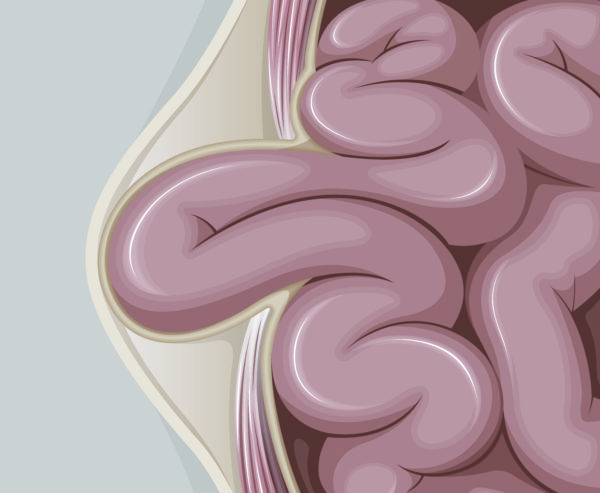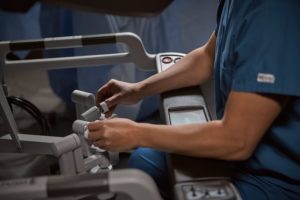Da Vinci Robotic-Assisted Surgery improves minimally invasive options for inguinal hernia and other pelvic area procedures.

An inguinal hernia is a bulging of the contents of the abdomen through a weak area in the lower abdominal wall.
The advent of the Da Vinci robotic platform has been a boon in pelvic surgery. The ability to dexterously manipulate structures and place sutures in this notoriously tight and difficult space has dramatically increased our capabilities to perform procedures minimally invasively. In addition, with surgical areas such as urology, gynecology, and colorectal surgery, robotics has become very popular as a tool to perform procedures that are beneficial to the patient and ergonomic for the surgeon.
According to the Da Vinci Surgery website, “an inguinal hernia happens when tissue, most often part of the intestine, bulges through a weak area of abdominal muscle in the groin area. Inguinal hernias make up about 75 percent of all hernias and are most common in men.”
With Da Vinci, the surgeon sits at a console beside the patient and operates using tiny instruments through a few small incisions. A camera provides a high-definition, 3D magnified view inside your body. The da Vinci system translates every hand movement your surgeon makes in real-time to bend and rotate the instruments with precision.
For 5 to 10 years, utilizing the Da Vinci robot in inguinal hernia repair has become increasingly popular. Versus open surgery, studies have repeatedly shown the repairs to be equivalent. While not currently proven, I suspect long-term data may even show superiority due to the mesh placement behind the fascia rather than over the top. In this setting, abdominal pressures drive the mesh into the fascia rather than away from it. This conceptually decreases the likelihood of abdominal contents protruding between the mesh and fascia, theoretically preventing recurrence. Additionally, robotic surgery allows bilateral hernias to be fixed from the same three small incisions.

With Da Vinci, the surgeon sits at a console next to you and operates using tiny instruments through a few small incisions (photo courtesy Da Vinci).
What about laparoscopic surgery? Plainly, the instruments are less facile. Whereas the Da Vinci instruments have a joint capable of pivoting the end of the device in a human-like fashion, laparoscopic instruments have been likened to “chopsticks,” making precise suturing and manipulation difficult. Rather than a few sutures placed to prevent mesh migration, in laparoscopic surgery, absorbable tacks are frequently employed for this purpose, often a source of postoperative pain. Alternatively, the mesh can be placed without being secured, relying on the peritoneum over the top and intra-abdominal pressure to hold the mesh in position. Still, I do not prefer this as it leaves the door open for the mesh to slide out of place or crumple.
All these factors make robotic surgery revolutionary in inguinal hernia repair. Patients can return home the same day with minimal pain and a secure, lasting mesh. For routine repair, this technique is my first choice.
Resources
Learn more about the Da Vinci Robotic System for:
 About Brian Smith, DO
About Brian Smith, DO
General Surgery
Dr. Smith performs open, minimally-invasive, and robotic surgeries and in-office procedures for ages 18+. His services include:
-
- Alimentary Tract – stomach, small intestine, colon, upper and lower endoscopy;
- Abdomen and its Contents – hernia of all types, diaphragm, biliary tract, liver, spleen;
- Breast, Skin, and Soft Tissue – benign and malignant disease;
- Endocrine – thyroid and parathyroid glands;
- Surgical Oncology – including coordinated management of the cancer patient in the above areas;
- Trauma – comprehensive management and responsibility for all phases of trauma care.

